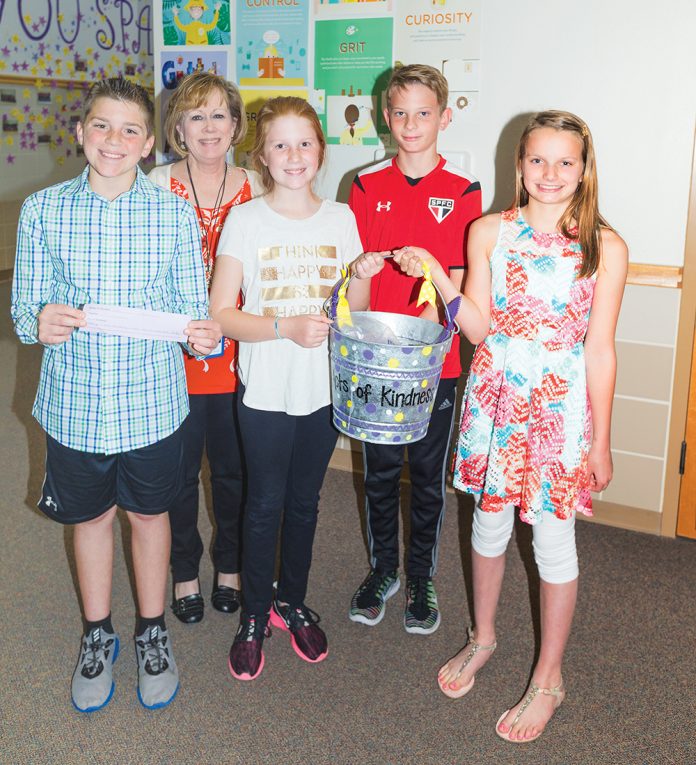On April 3, during the typical late spring chaos of the school year, the Frisco ISD took on the Happiness Advantage Challenge. Created by psychologist and author Shawn Achor, this 21-day experience was designed to shift perspectives and perceptions of reality, resulting in higher levels of happiness and lower levels of anxiety.
“FISD student assistance coordinator James Caldwell spearheaded the adoption of this movement,” says Laura Rose, the Frisco Council of PTA healthy lifestyles chair. “Something James said really stuck with me,” she says. “That right now, we all think if we succeed, make those good grades or get that job we want, then we are happy. When, really, it should be the other way around.” She saw this challenge as an opportunity to help students and families get to a place of knowing real happiness and self-worth, in turn, helping them succeed. For true success only comes to those who know happiness.
With state tests to pass, grades to make for graduation and colleges to select, not to mention everything the students’ parents and school staff do to help with these daunting tasks, everyone has something on their plate this time of year. “This program will be a way for us to promote a positive spirit while the end of the year is presenting a lot of anxiety and pressure on us all. If we all slow down and take time to focus on what we are truly grateful for, we can gain a new perspective on life,” said Sarah Perry, the guidance counselor at Tadlock Elementary. Guidance counselor Jody Clark, from Scoggins Middle School, sees the challenge as a way of changing the entire dynamic and culture in schools. “It is a chance for kids to see school as a truly positive place to be, which will help pull them up to their full potential in productivity and brain activity, making them better learners … more motivated learners.”
The FISD already has the inspiring Whole Child Initiative woven into its curriculum and purpose, which strives to meet every need, academic, social and emotional, of every student so they can reach their full potential. The Happiness Advantage Challenge was therefore a natural step to take across the entire district. Ms. Rose took charge in involving parents in the challenge by working with the healthy lifestyles chairs from all schools. “These chairs usually work with their P.E. instructors, making sure children’s physical and health needs are taken care of,” she explains. Now, they have taken on a new relationship with the guidance counselors as well, collaborating on plans to implement the challenge.
What is the Happiness Advantage?
Psychologists have discovered happiness is not dependent on circumstance, but rather on our perception of circumstance. Generally, we believe if we are happy, it is because good things are happening to us and we are succeeding. We also see unhappiness as a result of negative things happening to us or around us. Mr. Achor says circumstance only accounts for about 10 percent of our happiness. The other 90 percent is determined by how we perceive these circumstances in our minds. He explains, “If we can change somebody’s level of positivity in the present, then their brain experiences what we now call the ‘Happiness Advantage,’ which states that your brain, at positive stress, performs significantly better than when at negative or neutral stress.” Seeing stress as an opportunity instead of a threat increases a person’s productivity and performance.
So, how do we do this? How do we change the way we see the world? Mr. Achor breaks the task down to five easy steps. Step One: Show your gratitude by writing down three things you are truly grateful for each day. Step Two: Journal as you reflect on every day, including something positive that happened in the past 24 hours. Step Three: Display acts of kindness by taking time to thank someone, praise someone or let someone know they are appreciated and valued. Step Four: Exercise 10 minutes a day. Step Five: Meditate and reflect with prayer or quiet time. Even five minutes a day of completely unplugging and disengaging from the rush of society is enough.
The schools jumped right into these five daily practices, quickly realizing how easy it was to adopt them into their everyday lives. Each school was eager to put their own spin on the challenge.
Cheryl Salmon, a counselor at Sparks Elementary, was excited for people to begin the daily expressions of gratitude, believing this to be an eye-opening exercise. “They do not have to be huge things,” she says. “Maybe, one morning, I have time to sit on my porch and drink my coffee. That time I have with nature and the quiet, that is something I am grateful for that day.”
At Reedy High School, students wrote their “gratitudes” on posters hanging in the hallways, where they could read what everyone was thankful for. This broadened their perspectives on life’s gifts as they recognized the diversity in what their peers were grateful for.
Ms. Perry felt introducing this challenge to elementary students was particularly important. “Elementary school is the foundation for building character — for building the ‘whole child,’” she shares. At Tadlock Elementary, the students took quiet time after lunch and recess to journal about the day’s positives. This kind of reflection started to become a habit the students will be able to take with them as they grow. Ms. Rose believes, in alignment with Mr. Achor’s teachings on the Happiness Advantage, that “journaling about the good things allows you to re-live them. And when you are remembering them so fully, you can focus on the positive things that happen every day more easily.”
To encourage daily acts of kindness, Sparks Elementary introduced a Kindness Bucket. Students and teachers submitted slips of paper describing kindnesses they witnessed throughout the school. Staff and teachers recognized students at the weekly assembly as they read out the acts of kindness, demonstrating the impact even a simple gesture can have.
Kids and parents were urged to spend more time together at home, without distractions or deadlines or stress on the mind. “This is a chance to change the way we interact with each other,” said Ms. Salmon. “When we take time to focus on our happiness, we can help create it in others.”
In three short weeks, benefits reached every age of student and even extended into their home lives. The challenge helped the youngest students form habits of behavior and perception, so as they get older and start experiencing more stressful times, they can readily handle it all. Middle schoolers experience the pressures of trying to keep up with peers, as cliques and interests shift and classes intensify. These can be so consuming for kids who are just trying to fit in and cause a lot of anxiety. Learning how to notice the good in their lives and appreciate their peers helped them slow down and realize there is more to life than these pressures. For high schoolers, it has become almost second nature to consider academic success the top priority, especially as they near college applications and acceptances. Having them take a step back and notice everything there is to be truly happy about allowed them to relax, take a breath and, in turn, be more successful in school.
Frisco has every hope of revisiting the Happiness Advantage Challenge next year and every year after. Nancy Jo Lambert, the librarian at Reedy High School, says, “Ultimately, the hope is that we can help our community create happiness habits that will have a positive impact on people’s outlook on life.” Coming together as a community in this way will change people’s lives for the better, and with it, we can raise a generation of the most positively successful individuals to take on the world.
Editor’s note: You may consider involvement in a local faith community to better their lives and find fulfillment. Often, understanding and engaging with others about a bigger purpose for life can bring a solid foundation for happiness that goes beyond circumstances.


